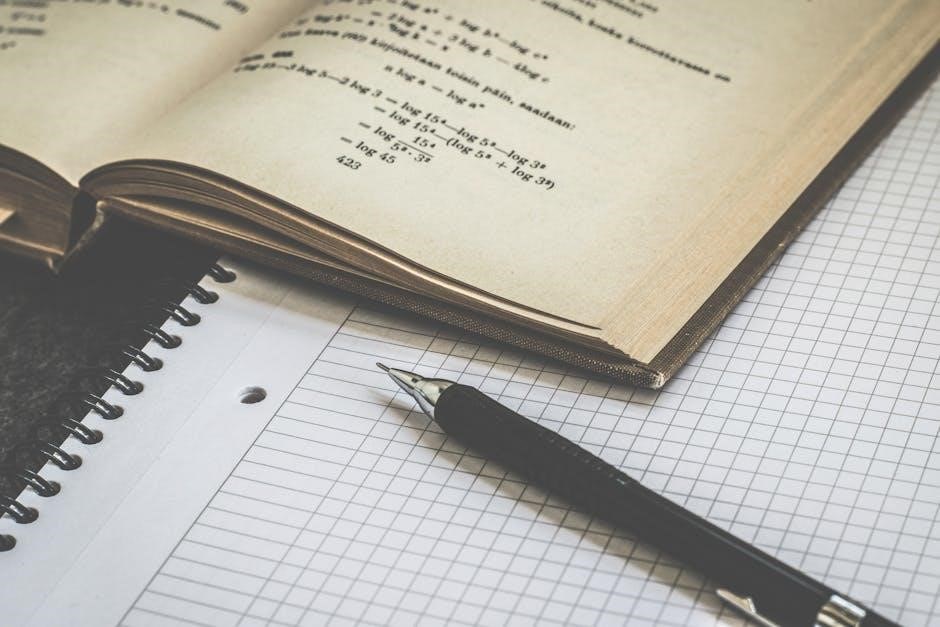The 3rd Grade Math Common Core Standards focus on developing a strong foundation in operations, base ten understanding, geometry, and problem-solving. These standards emphasize critical thinking and real-world application, ensuring students master essential math skills.
Overview of the Standards
The 3rd Grade Math Common Core Standards are designed to build a strong mathematical foundation, focusing on critical areas such as multiplication, division, place value, and geometry. These standards emphasize problem-solving, reasoning, and the ability to apply math to real-world situations. They are structured to ensure coherence and consistency across grade levels, with a focus on depth over breadth. The standards include clusters of related skills, such as understanding properties of operations and solving two-step word problems. They also highlight the importance of mathematical practices, like perseverance and precision, to foster a deep understanding of mathematical concepts.

Operations and Algebraic Thinking
This domain focuses on developing skills in multiplication, division, and understanding properties of operations. Students learn to solve problems involving these operations and apply them strategically.
Solving Multiplication and Division Problems
Students in 3rd grade learn to interpret and solve multiplication and division problems using various strategies. They understand multiplication as groups of objects and division as sharing or grouping. Visual models, such as arrays and area models, are used to represent these operations. The standards emphasize applying properties of operations, like the commutative property of multiplication, to simplify problem-solving. For example, knowing that 6 × 4 = 24 helps understand that 4 × 6 = 24. Students also explore real-world applications and word problems, ensuring a deep understanding of these foundational concepts.
Understanding Properties of Operations
Third graders explore properties of operations to enhance problem-solving skills. They apply the commutative property of multiplication (e.g., 6 × 4 = 4 × 6) and addition (e.g., 7 + 2 = 2 + 7). Students also learn the associative property, understanding that grouping numbers differently doesn’t change the result. For example, (3 + 5) + 2 = 3 + (5 + 2). These properties help simplify calculations and promote flexible thinking. By recognizing patterns and relationships, students develop a deeper grasp of mathematical operations, preparing them for more complex concepts in higher grades.
Two-Step Word Problems
Third graders tackle two-step word problems, requiring the use of multiple operations to find solutions. These problems often involve addition, subtraction, multiplication, or division in sequence. For example, “Tom has 12 apples in one basket and 8 in another. He gives 5 to his friend. How many apples does Tom have left?” Students must first add (12 + 8) and then subtract (20 ⸺ 5) to find the answer. These problems enhance critical thinking and encourage the use of various strategies, such as drawing models or writing equations, to break down and solve complex scenarios effectively.

Number and Operations in Base Ten
Third graders build skills in understanding place value, performing multi-digit arithmetic, and interpreting numbers up to 1,000. They learn to read, write, and compare numbers, using mental math strategies to solve problems efficiently.
Place Value Understanding
Students in third grade develop a robust understanding of place value, recognizing the significance of hundreds, tens, and ones. They learn to read and write numbers up to 1,000, using numerals, words, and expanded form. This includes understanding that 100 is ten times 10 and that each place value represents a power of ten. They also compare and order numbers based on their place value, laying a foundation for multi-digit operations. Activities involve decomposing numbers into hundreds, tens, and ones to solve real-world problems, enhancing their numerical fluency and conceptual grasp of base ten principles.
Multi-Digit Arithmetic
Third graders develop skills in multi-digit arithmetic, focusing on adding and subtracting numbers up to three digits. They use place value understanding to decompose numbers, employing standard algorithms and mental math strategies. Students also explore the relationship between addition and subtraction, applying these operations to solve real-world problems. Instruction emphasizes the importance of accuracy and efficiency, preparing students for more complex arithmetic in higher grades. By mastering these concepts, learners build a strong numerical foundation and improve their problem-solving abilities in mathematical contexts.

Geometry
In Grade 3, students explore geometry by recognizing and analyzing shapes, understanding their attributes, and using basic properties to compose and decompose figures effectively.
Recognizing and Analyzing Shapes
Third graders learn to identify and describe basic shapes, including triangles, quadrilaterals, pentagons, and hexagons. Students analyze their attributes, such as the number of sides, vertices, and angles. They also recognize and create shapes by composing and decomposing simpler shapes into more complex forms. This understanding helps students classify shapes into categories and identify their properties. Real-world applications, like identifying shapes in everyday objects, enhance their spatial awareness and problem-solving skills. These foundational geometry skills prepare students for more advanced concepts in later grades.

Measurement and Data
Third graders learn to measure liquid volumes and masses using standard units, apply arithmetic operations to solve problems, and interpret data through charts and graphs effectively.
Measuring Liquid Volumes
Third graders learn to measure liquid volumes using standard units such as liters (l) and milliliters (ml). Students estimate and compare volumes, solving problems involving addition, subtraction, multiplication, and division. They apply these skills to real-world scenarios, such as measuring ingredients for a recipe or calculating the amount of water needed for a task. Understanding these concepts helps build a foundation for more complex measurements in higher grades. The standards emphasize accuracy and the ability to interpret data related to liquid volumes, ensuring students can apply their knowledge practically and effectively in various situations.
Mathematical Practices
Mathematical Practices in 3rd grade focus on problem-solving, reasoning, and critical thinking. Students learn to apply math in real-world scenarios, developing a deep understanding of concepts through exploration and application.
Problem-Solving and Reasoning
Problem-solving and reasoning are central to 3rd grade math standards. Students learn to apply mathematical concepts to real-world situations, using the four operations and multi-step strategies. They identify patterns, justify solutions, and explain reasoning. Emphasis is placed on critical thinking and logical approaches. By engaging in collaborative problem-solving, students develop fluency in arithmetic and deepen their understanding of mathematical relationships. These skills prepare them for more complex challenges in higher grades, fostering confidence and analytical thinking.

Resources and Implementation
Teachers and parents can access 3rd Grade Math Common Core Standards PDFs, lesson plans, and assessments online. These resources provide structured guides for teaching and evaluating student progress effectively.

Locating PDFs and Lesson Plans
Official PDFs of the 3rd Grade Math Common Core Standards are available on state education websites and platforms like corestandards.org. These documents provide detailed outlines of expectations for operations, base ten understanding, and geometry. Additionally, lesson plans and teaching resources can be found on educational portals such as TeachThought and Achieve the Core. These materials include sample problems, activities, and assessments to support implementation. Educators can also access curated lists of standards-aligned tools through state departments of education, ensuring alignment with curriculum goals and student needs.
Assessment Strategies
Assessment strategies for 3rd Grade Math Common Core Standards involve a combination of formative and summative evaluations. Teachers use quizzes, class discussions, and performance tasks to monitor progress. Standardized tests, such as end-of-unit assessments, measure mastery of skills like multiplication and place value. Performance tasks, like solving multi-step word problems, evaluate critical thinking and application. Digital tools and portfolios are also employed to track student growth. These strategies ensure alignment with standards and provide actionable feedback to guide instruction and improve student outcomes. Regular assessments help identify areas needing additional support, ensuring all students meet expectations.
Mastering 3rd Grade Math Common Core Standards is crucial for building a strong academic foundation, fostering critical thinking, and preparing students for future success in STEM fields and beyond.
Importance of Mastering These Standards
Mastering 3rd Grade Math Common Core Standards is essential for developing a strong mathematical foundation. These standards emphasize critical thinking, problem-solving, and real-world application, preparing students for future academic success. By focusing on operations, base ten concepts, and geometry, students build skills necessary for STEM fields and everyday problem-solving. Proficiency in these standards ensures readiness for higher-grade challenges and fosters a deep understanding of mathematical principles. This foundation is crucial for long-term academic and career success, enabling students to approach complex tasks with confidence and precision.
